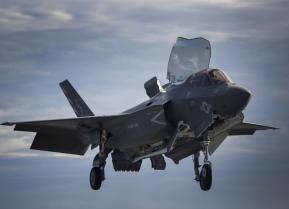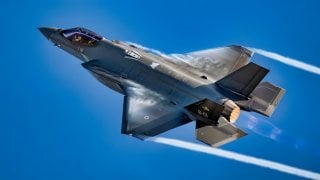The Air Force's F-35A Fighter Is Now a Nuclear Bomber
The F-35A, Lockheed Martin's advanced stealth fighter, has attained operational certification to carry the B61-12 thermonuclear gravity bomb, marking it as the first 5th generation aircraft with nuclear capabilities.
Summary: The F-35A, Lockheed Martin's advanced stealth fighter, has attained operational certification to carry the B61-12 thermonuclear gravity bomb, marking it as the first 5th generation aircraft with nuclear capabilities. With this milestone achieved ahead of schedule, the F-35A becomes a pivotal component of the US and NATO's extended deterrence commitments. This development highlights the aircraft's versatility as a dual-capable platform, capable of delivering both conventional and nuclear payloads. As NATO-operated jets receive initial certification for the deterrence mission, the integration of the B61-12 further enhances the F-35A's combat capability, solidifying its role in modern warfare.
F-35 Lightning II: Now Nuclear-Capable, Ushering in a New Era of Combat
The Lockheed Martin F-35 Lightning II has been touted as being the most advanced multirole combat aircraft in service in the world today, and according to a new report – it is now a nuclear-capable warbird.
Breaking Defense first reported on Friday that the F-35A, the conventional takeoff and landing variant, has been operationally certified to carry the B61-12 thermonuclear gravity bomb.
In a statement, F-35 Joint Program Office (JPO) spokesman Russ Goemaere told Breaking Defense the certification was achieved on October 12, months ahead of a pledge to NATO allies that the process would wrap by January 2024. An undisclosed number of F-35As will now be capable of carrying the B61-12, officially making the stealth fighter a "dual-capable" aircraft that can carry both conventional and nuclear weapons.
"The F-35A is the first 5th generation nuclear-capable aircraft ever, and the first new platform (fighter or bomber) to achieve this status since the early 1990s. This F-35 Nuclear Certification effort culminates 10+ years of intense effort across the nuclear enterprise, which consists of 16 different government and industry stakeholders," said Goemaere. "The F-35A achieved Nuclear Certification ahead of schedule, providing US and NATO with a critical capability that supports US extended deterrence commitments earlier than anticipated. "
As previously reported by Maya Carlin for The National Defense in December, some North Atlantic Treaty Organization-operated jets had received "initial certification for the deterrence mission."
The F-35A is only certified to carry the B61-12 variant, the latest variant of the United States military's B61 family of air-launched nuclear gravity bombs. It is a combination of new and refurbished components from earlier variants including the B61-3, B61-4, B61-7, and B61-10. Moreover, the certification additionally does not extend to the stealth jet's sister variants, the short takeoff and vertical landing F-35B and carrier-launched F-35C.
The B61-12, which is twelve feet long and weighs approximately 825 pounds, is an air-launched nuclear gravity bomb that utilized an inertial navigation system (INS) to make a precision strike on a target. It was first integrated with the U.S. Air Force's F-15E Strike Eagle, where it is carried externally. The weapon will also be certified to be carried on the Air Force’s B-2 Spirit strategic bomber, as well as the F-16C/D fighter.
Analysis from the Federation of American Scientists reports that as of last summer, there are approximately 100 older variants of the B61 bombs housed by NATO forces in Belgium, Germany, Italy, the Netherlands, and Turkey. The first of those nations either currently or plan to operate the fifth-generation stealth fighter.
Getting the F-35 Ready For the Nuclear Mission
In 2021, the F-35A became the first fifth-generation platform to near certification as a nuclear-capable airframe. The improvements to the already-advanced F-35 will boost the combat capability of the stealth fighter jet. These improvements will allow it to penetrate hostile airspace without warning and possibly be a part of the United States military's nuclear triad.
Unlike with the other fighters, including the F-15 and F-16, the B61-12 will be carried internally in the F-35.
The B61-12 was first successfully flight-tested to carry the B61-12 nuclear bomb at the Sandia National Laboratories' Tonopah Test Range, Nevada, in late 2020. An F-35A carried a mock warhead, which was used in a strike from an altitude of 10,500 feet, as part of a full-weapons systems demonstration that was designed to increase confidence the bomb would “work when needed.”
Author Experience and Expertise: Peter Suciu
Peter Suciu is a Michigan-based writer. He has contributed to more than four dozen magazines, newspapers, and websites with over 3,200 published pieces over a twenty-year career in journalism. He regularly writes about military hardware, firearms history, cybersecurity, politics, and international affairs. Peter is also a Contributing Writer for Forbes and Clearance Jobs. You can follow him on Twitter: @PeterSuciu. You can email the author: [email protected].


